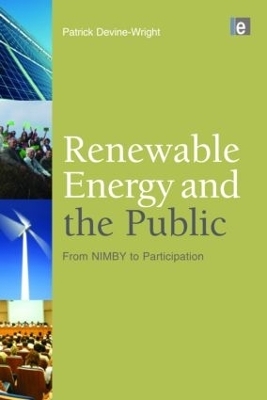
Renewable Energy and the Public
Earthscan Ltd (Verlag)
978-1-84407-863-9 (ISBN)
Throughout the world, the threat of climate change is pressing governments to accelerate the deployment of technologies to generate low carbon electricity or heat. But this is frequently leading to controversy, as energy and planning policies are revised to support new energy sources or technologies (e.g. offshore wind, tidal, bioenergy or hydrogen energy) and communities face the prospect of unfamiliar, often large-scale energy technologies being sited near to their homes. Policy makers in many countries face tensions between 'streamlining' planning procedures, engaging with diverse publics to address what is commonly conceived as 'NIMBY' (not in my back yard) opposition, and the need to maintain democratic, participatory values in planning systems.
This volume provides a timely, international review of research on public engagement, in contexts of diverse, innovative energy technologies. Public engagement is conceived broadly - as the interaction between how developers and other key actors engage with publics about energy technologies (including assumptions held about the methods used, such as the provision of financial benefits or the holding of deliberative events), and how individuals and groups engage with energy policies and projects (including indirectly through the media and directly through emotional and behavioural responses).
The book's contributors are leading experts in the UK, Europe, North and South America and Australia drawn from a variety of relevant social science disciplinary perspectives. The book makes a significant contribution to our existing knowledge, as well as providing interested professionals, policymakers and members of the public with a timely overview of the critical issues involved in public engagement with low carbon energy technologies.
Prof. Devine-Wright researches social and psychological aspects of new energy infrastructure such as wind farms, drawing on the concepts of place attachment and place identity to explain 'NIMBY' responses. He is based at the University of Exeter, UK.
Introduction (Patrick Devine-Wright, University of Exeter, UK)
Section 1: Conceptual approaches
1. Symmetries, expectations, dynamics and contexts: a framework for understanding public engagement with renewable energy projects (Walker, University of Lancaster, UK, and colleagues)
2. The principles, procedures, and pitfalls of public engagement in decision-making about renewable energy (Haggett, University of Edinburgh, UK)
3. Beyond consensus? Agonism, republicanism and a low carbon future (Barry and Ellis, Queens' University, Belfast, N. Ireland)
4. Public roles and socio-technical configurations: diversity in renewable energy deployment in the UK and its implications (Walker and Cass, University of Lancaster, UK)
5. From Backyards to Places: Public engagement and the emplacement of renewable energy technologies (Patrick Devine-Wright, University of Exeter, UK)
Section 2: Empirical studies of public engagement
Part 1: Stakeholder and media representations of public engagement
6. Discourses on the implementation of wind power: Stakeholder views on public engagement (Wolsink, University of Amsterdam, Netherlands)
7. Governing the Reconfiguration of Energy in Greater London: Practical Public Engagement as 'Delivery' (Hodson and Marvin, University of Salford, UK)
8. Envisioning public engagement with renewable energy: an empirical analysis of images within the UK National Press 2006/7 (Hannah Devine-Wright, University of Manchester, UK)
9. NIMBYism and community consultation in electricity transmission network planning (Cotton and Patrick Devine-Wright, University of Exeter, UK)
Part 2: Case studies of public beliefs and responses
Future energy scenarios
10. Turning the heat on: Public engagement in Australia's energy future (Ashworth, Littleboy, Graham & Niemeyer, Commonwealth Scientific and Industrial Research Organisation, Australia)
Solar energy and microgeneration
11. Shaping people's engagement with microgeneration technology: the case of solar photovoltaics in UK homes (Abi-Ghanem, Imperial College London and Haggett, University of Edinburgh, UK)
12. Siting Solar Power in Arizona: A Public Value Failure? (Pasqualetti and Schwartz, Arizona State University, USA)
13. Socio-Environmental Research on Energy Sustainable Communities: Participation Experiences of Two Decades (Schweizer-Ries, University of Saarland, Germany)
14. Yes in my back yard: UK householders pioneering microgeneration heat (Roy and Caird and Roy, Open University, UK)
Wind energy
15. Socio-environmental impacts of Brazil's first large-scale wind farm (Improta and Pinheiro, Federal University of Rio Grande do Norte, Natal, Brazil)
16. Perceptions and Preferences Regarding Offshore Wind Power in the United States - The Leading Edge of a New Energy Source for the Americas (Firestone, University of Delaware, USA)
Hydrogen energy:
17. The limits of upstream engagement in an emergent technology: lay perceptions of hydrogen energy technologies (Flynn, Bellaby and Ricci, University of Salford, UK)
18. Public engagement with wind-hydrogen energy technology: a comparative study (Sherry-Brennan, Devine-Wright and Devine-Wright, University of Exeter, UK)
Marine energy
19. Symbolic interpretations of wave energy in the UK: surfers' perspectives (McLachlan, University of Manchester, UK)
Bioenergy
20. Heat and light: understanding bioenergy siting controversy (Upham, University of Manchester, UK)
Nuclear and low carbon energy
21. From the Material to the Imagined: Public Engagement with Low Carbon Technologies in a Nuclear Community (Butler, Parkhill and Pidgeon, Cardiff University, Wales, UK)
Conclusions (Devine-Wright, University of Exeter, UK)
| Erscheint lt. Verlag | 3.11.2010 |
|---|---|
| Verlagsort | London |
| Sprache | englisch |
| Maße | 156 x 234 mm |
| Gewicht | 635 g |
| Themenwelt | Naturwissenschaften ► Biologie ► Ökologie / Naturschutz |
| Naturwissenschaften ► Geowissenschaften ► Geografie / Kartografie | |
| Technik ► Elektrotechnik / Energietechnik | |
| Technik ► Umwelttechnik / Biotechnologie | |
| ISBN-10 | 1-84407-863-9 / 1844078639 |
| ISBN-13 | 978-1-84407-863-9 / 9781844078639 |
| Zustand | Neuware |
| Haben Sie eine Frage zum Produkt? |
aus dem Bereich


